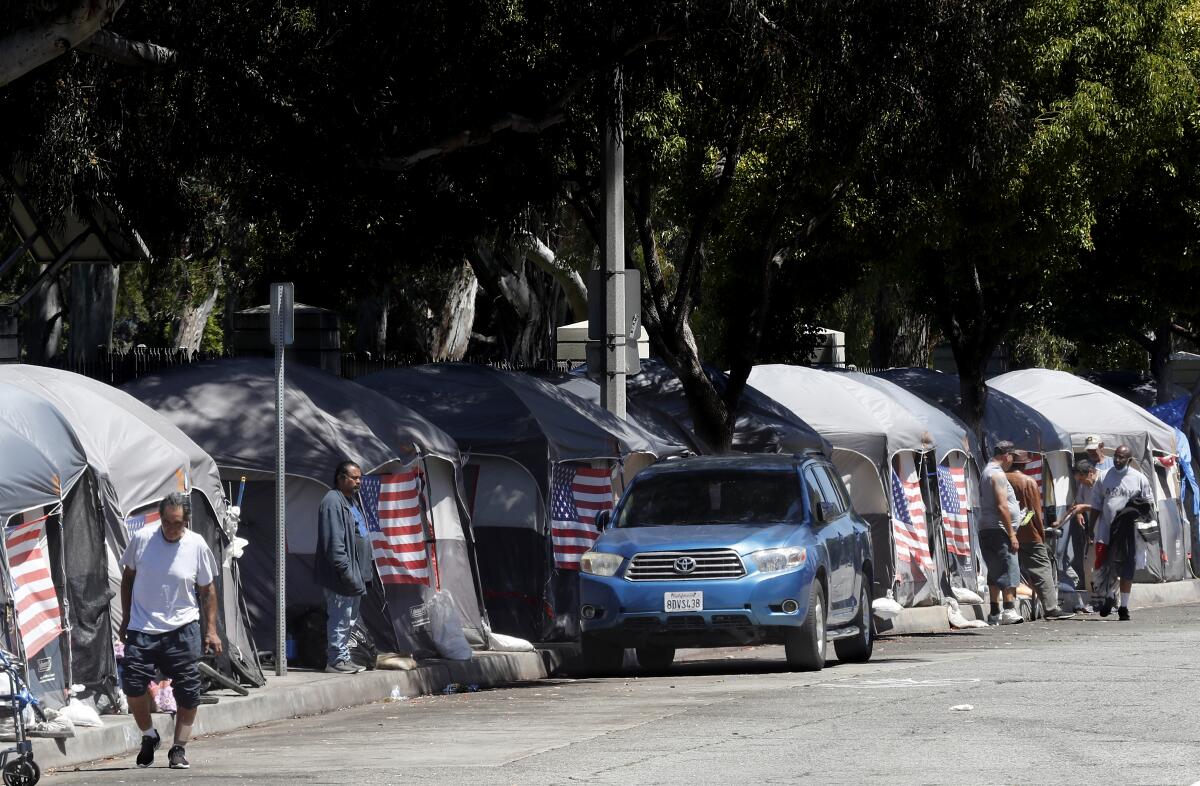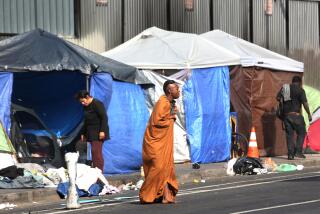Editorial: Living in an encampment shouldnât put you first in line for homeless housing

Homeless encampments have gotten a lot of attention in the last couple of weeks in Los Angeles. The city has about 41,000 homeless people, but encampments with dozens or even hundreds of inhabitants have particularly raised the ire of neighborhoods that see them â to varying degrees of accuracy â as magnets for trash, crime or fire, and as eyesores on sidewalks and in parks.
In the days since the Echo Park Lake homeless encampment dwellers were moved out and the property fenced off, residents in several other neighborhoods have called for city officials to disband camps in their areas.
But the city has scarce resources to house its homeless residents, temporarily or permanently. (And thatâs a travesty.) Currently, hotels and motels leased through Project Roomkey, a federally funded program for sheltering homeless people, are pretty much booked up.
So what should the city do? Offer temporary housing to homeless people in every encampment in the city? Or offer it to every encampment in a neighborhood with enough organizational skills to complain loudly? The latter is essentially what happened in Echo Park.
The bottom line is this: While every homeless person needs housing, interim solutions along the lines of the cityâs bridge shelters and Project Roomkey rooms should be offered to the people who need them most desperately. Some of those will be people in encampments and some wonât. People whose age, physical problems or mental conditions make them the most vulnerable on the streets â as assessed by the L.A. Homeless Services Authority â are the ones who are most in need of shelter and housing.
They are the ones most likely to die on the streets. And they are the ones who make the most demands on the service system through police calls and emergency room visits. They are also the people who are most likely to be eligible for permanent supportive housing when itâs available, so there really is a path for them from shelter to permanent housing.
That said, the city needs to be flexible as well. Its bridge shelter program was built on the premise that these beds would draw homeless people from the neighborhoods in which they are located. Thatâs fine. But there arenât enough bridge shelters to go around.
The impetus behind the clearing of Echo Park Lake was not just that it was an encampment but that it was an encampment in a park. And as supporters of the clearing have stressed, parks are intended for shared community use.
Other groups in other neighborhoods see encampments as dangers that need to be moved. One in Venice wants the city to relocate a boardwalk encampment that holds 100 to 150 people, by the Homeless Service Authorityâs estimate. Residents and businesses complain about piles of trash and note that some 20 fires originated with homeless people in Venice in the past several years. (An L.A. Fire Department spokesman says those incidents range from trash can fires to buildings that ignited.) And the Brentwood Community Council is pushing to relocate people from a large encampment on a sidewalk outside the grounds of the Department of Veterans Affairs, calling the camp âneither safe nor humane.â Police allege that last weekend, a man who lives in the encampment ran his car over another camp dweller, killing him. The suspect was arrested and is being held in jail.
No one should have to live in an encampment. The question is how to balance the encampment dwellersâ needs for shelter and housing with the needs of the rest of the cityâs homeless people. In Brentwood, the most urgent issue was to remove the accused killer. The police have done that. In Venice, although the beach is technically a park, you canât easily fence it off and keep out homeless people as the city did with Echo Park Lake. Still, people should not be camping there.
The sooner the city comes up with more innovative solutions for housing homeless people at least temporarily, the sooner they can be moved out of parks and off sidewalks â not just in Venice and Brentwood, but all across Los Angeles.
City Councilman Mike Bonin, whose district includes both Venice and Brentwood, has suggested using several county-owned parking lots, including at Will Rogers State Beach and Dockweiler Beach, as sites for safe camping or tiny houses. He also wants to turn some space in his Westside district office into a womenâs shelter. But on the whole, Bonin said, affordable and available government-owned sites in his district are difficult to come by, and private owners of suitable sites are often unwilling to lease.
His proposal to use beach parking lots has angered some of his constituents, but hereâs the reality: There is no Goldilocks place for homeless people. We have to find shelter and housing in our communities and make it work. If you know of suitable buildings or lots in your neighborhood, tell your City Council member.
More to Read
A cure for the common opinion
Get thought-provoking perspectives with our weekly newsletter.
You may occasionally receive promotional content from the Los Angeles Times.










